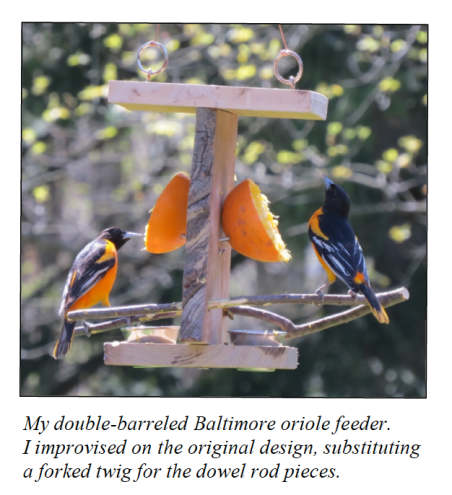If you build it, they might come
 For years, I tried to lure Baltimore orioles to the feeders. One year I got a pair to stay the summer but, for the most part, a few orioles would stop by, wet their beaks at the nectar feeder and press on. They either moved on to “oranger” and “purpler” pastures down the road where people offered oranges and grape jelly, or continued on their northward migration.
For years, I tried to lure Baltimore orioles to the feeders. One year I got a pair to stay the summer but, for the most part, a few orioles would stop by, wet their beaks at the nectar feeder and press on. They either moved on to “oranger” and “purpler” pastures down the road where people offered oranges and grape jelly, or continued on their northward migration.
After I retired and had way too much time on my hands, I resolved to go all out to keep the orioles at the feeders. At the first sighting, I ran out to Kroger and stocked up on oranges and grape jelly.
I crammed orange halves into suet cages and hung them out. I dabbed the grape jelly into recesses around the rim of a nectar feeder that we’d put out for them earlier in the spring.
It didn’t take long to see that simply putting nectar out for the orioles had been woefully inadequate — like trying to keep a free agent ballplayer from bolting to another team by offering him minimum wage. Within two days, the feeders were ablaze with flashes of bright orange plumage. About a half-dozen male orioles and two or three females converged on the feeders, jockeying for position on the improvised orange and grape jelly feeders.
It was obvious that, if I was going to make the jump to the big leagues of oriole-feeding, better accommodations were in order. A quick Internet search turned up a simple two-station feeder with an orange half and small cup of jelly at each perch. It was a basic design, requiring three small hunks of wood, deck screws and a couple pieces of dowel rod. It was simple enough that even an “unhandyman” like me could do it. (I have been called the Anti-Villa because I sorely lacked whatever talents do-it-yourself guru Bob Villa possessed.)
I went out to the barn, pried a white oak plank off the side that nobody ever sees and went to work. Within two hours, I had a serviceable Baltimore oriole feeder. It didn’t matter that it ended up looking an awful lot like the woodshop project I brought home from middle school. My parents proudly displayed my handiwork on the living room mantel, where they would entertain house guests by having them guess what it was supposed to be.
It was meant to be a shoeshine box — with a compartment below to stow polish and brushes and a sole-shaped appendage on top, where you were supposed to prop your shoe to polish it. My project looked more like a dresser drawer that had fallen off the back of a moving pickup truck, careened down the pavement for 50 or 60 yards and ended up in a contorted heap along the berm.
The orioles proved less judgmental than my parents and our house guests. They gave the feeder rave reviews, squabbling over spots on the perches, where they devoured the orange halves and emptied the jelly cups in a matter of hours.
After the orioles migrate south, I’ll take down the feeder. Maybe, during the winter, I can use it as a shoeshine box.